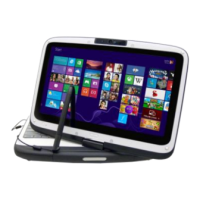
Do you have a question about the ECS EC10II2 and is the answer not in the manual?
Disclaimer regarding accuracy and liability for use of the manual.
Details of the Intel Celeron Processor 847 and its specifications.
Information on memory module type, speed, and supported RAM.
Specifies the Intel NM70 Express Chipset used in the device.
Details the Realtek ALC269Q-VB6 audio codec and its features.
Information on the 2-in-1 SDHC/MMC memory card reader and USB 2.0 interface.
Specifications for the 10/100 Mb/sec LAN controller.
Details on Wireless LAN specifications including Wi-Fi and Bluetooth.
Details of the integrated QWERTY keyboard, spill-resistance, and multi-language support.
Information about the PS/2 Touch Pad with gesture function support.
Specifications for SSD and HDD storage options, including protection features.
Details of the 10.1" HD LCD display with anti-glare coating.
Information on the capacitive 5-point touch screen functionality.
Specifications for 3-cell, 6-cell, and extended 6-cell Li-ion battery packs.
Details of the AC adapter with automatic voltage adjustment and power rating.
BIOS features including support for PuP & ACPI 2.0 and external USB boot.
Dimensions and weight of the convertible PC.
Compliance with EMC standards (CE, FCC, CCC).
Compliance with RF standards (FCC&SAR / R&TTE).
Certifications related to safety (UL/CB).
Details on various tests and compliance standards like Energy Star and MIL-STD.
Instructions for cleaning and maintaining the computer to prevent damage or shock.
FCC notice regarding modifications, compliance, and interference.
Details on CE marking compliance with EMC, Low Voltage, and R&TTE directives.
Statement on digital apparatus compliance with Canadian radio interference regulations.
User notification regarding FCC rules on device modifications.
Requirements for using shielded cables with peripheral connections.
Information on FCC RF Exposure Limit and antenna positioning.
Statement of compliance with FCC Part 15 rules.
Statement on telecommunications network requirements and connection.
Information on AC adapter power cord specifications and local area requirements.
Specifications for power cord sets in the U.S. and Canada.
Requirements for power cord fittings and specifications for other countries.
Warning about lithium battery used for clock and calendar circuitry.
An overview of the computer's features and components.
Instructions on how to open the LCD panel of the computer.
Identification of components on the front view of the computer.
Details on using the built-in rotating camera for video and photo.
Information about the computer's main display panel.
Function of the Windows Key button for switching modes.
Explanation of the LED status indicators on the computer.
Information on the use of the built-in microphone.
Indication of system status via the power LED.
Instructions for using the power/suspend button.
Overview of the touchpad as a pointing device and its buttons.
Identification of ports and controls on the left side of the computer.
How to adjust the volume using the dedicated buttons.
Function of the screen rotation lock button.
Identification of ports and features on the right side of the computer.
Location and purpose of the stylus pen slot.
Connecting headphones and microphones to the computer.
Information on USB 2.0 ports and their standards.
Using the Ethernet/LAN port with EMI shielding cable.
Connecting the AC adapter to the power jack.
Identification of components on the rear of the computer.
Using the handle, name field, rotating bar, and security slot.
Identification of components on the bottom of the computer.
Location of the battery bay and description of built-in stereo speakers.
Precautionary measures for spill resistance on keyboard and buttons.
Steps to avoid damage to the system from spills.
Instructions for connecting the AC adapter to power the computer.
Procedure for powering on the computer and the POST process.
Information on operating the computer using the rechargeable battery pack.
Warnings about using inferior extension cords and AC adapters.
Step-by-step instructions for installing the battery pack.
Step-by-step instructions for removing the battery pack.
Explanation of low battery warnings and system alerts.
Instructions on charging the battery and estimated charging times.
How to check the remaining battery power using the OS indicator.
Tips and methods to extend the battery's life and usage cycles.
Procedure for calibrating the battery for optimal performance.
Overview of Operating System power management features.
Explanation of system suspend modes like Standby Suspend.
Details on the Hibernate Suspend mode and power saving.
How the power button functions to turn off or suspend the system.
Methods for adjusting display mode and brightness using key combinations.
Precautions for handling and cleaning LCD screens.
Explanation of function keys and their shortcut operations.
How to use the touchpad for cursor movement and clicking.
Important precautions to take when using the touchpad.
Procedure for resetting the system and troubleshooting unresponsive states.
Instructions on how to rotate the display panel horizontally or vertically.
How to use the display panel in a writing pad configuration.
Explanation of the HDD protection application against shocks.
Steps to enter the BIOS setup utility.
Procedure for exiting the BIOS setup utility.
Table of BIOS action keys and their functions.
Guide to modifying BIOS settings and navigating sub-menus.
Changing time/date and viewing processor/memory information in BIOS.
Configuration options for advanced system settings in BIOS.
BIOS security features including password settings and boot authentication.
Configuring boot priority order and related settings in BIOS.
Options for saving, discarding, or loading BIOS settings.
Common checks for power, cables, keyboard, and drivers.
Addressing problems caused by software programs and consulting vendors.